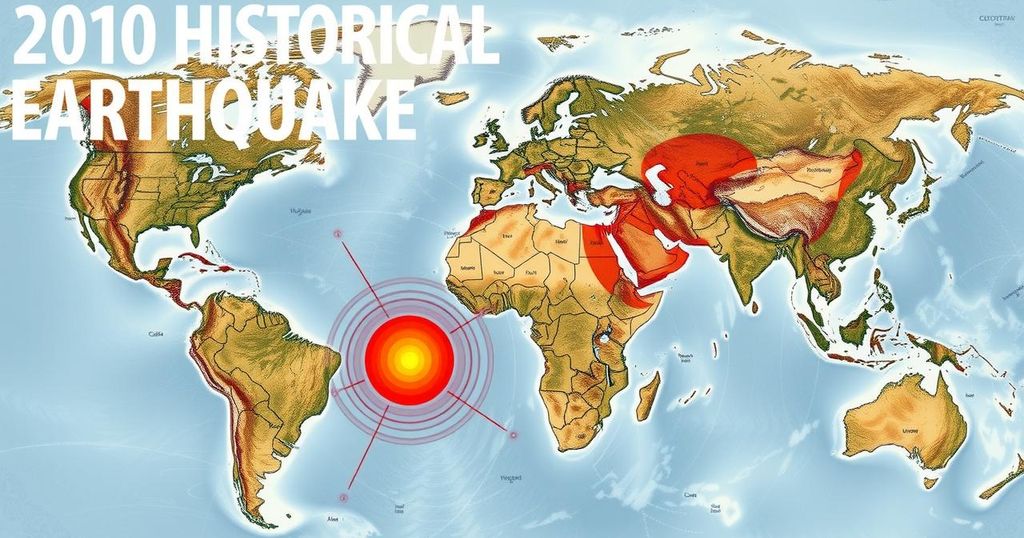World news
ASIA, BRITISH GEOLOGICAL SURVEY, EARTHQUAKE, EARTHQUAKES, FUKUSHIMA NUCLEAR PLANT, JAPAN, NATURAL DISASTER, NATURAL DISASTERS, NORTH AMERICA, PACIFIC, PACIFIC PLATE, PERU, SENDAI, SHALLOW EARTHQUAKE, SOUTH AMERICA, UNITED STATES, WESTERN STATES SEISMIC POLICY COUNCIL
Lena Nguyen
0 Comments
The Largest Earthquakes in Recorded History
This article examines the five largest earthquakes in recorded history, including their magnitudes, impacts, and the resulting tsunamis. It explores how these seismic events have affected various regions, particularly along the Pacific ‘Ring of Fire’. Major earthquakes highlighted include the 2004 Indian Ocean earthquake and tsunami, the 2011 Japan earthquake, and the 1960 Chile earthquake.
Throughout history, certain earthquakes have left indelible marks due to their catastrophic power. The 2004 Boxing Day earthquake, registering a magnitude of 9.1, struck the Indian Ocean and resulted in relentless destruction, claiming more than 220,000 lives across multiple nations. Earthquakes are notably prevalent in various regions globally, particularly along the Pacific Plate, which makes up the famous ‘Ring of Fire’, where over 80 percent of significant earthquakes occur. This region affects areas in East Asia, as well as the western coastlines of the Americas, making it a hotspot for seismic activity.
The fifth most powerful earthquake was recorded in Russia in 1952, with a magnitude of 9.0. The earthquake affected Severo-Kurilsk and led to a tsunami with waves reaching 50 feet, resulting in 10,000 to 15,000 fatalities. The tsunami impacted areas far beyond Russia, affecting locations from New Zealand to Hawaii.
In Japan, the 2011 earthquake also registered a magnitude of 9.0, occurring off the coast of Honshu. The quake generated massive tsunamis, with waves reaching 33 feet, and caused severe consequences at the Fukushima nuclear plant, leading to nuclear meltdowns and radiation leaks. Approximately 18,000 individuals lost their lives or went missing as a result of this disaster.
The Indian Ocean experienced a seismic disaster on December 26, 2004, when an undersea earthquake resulted in the worst tsunami crisis in recorded history. The magnitude 9.1 earthquake impacted various countries, killing over 230,000 people and devastating coastal communities in nations such as Indonesia, Thailand, and India.
Following this, the 1964 Good Friday earthquake registered a remarkable magnitude of 9.2 in Alaska, shaking the region for four minutes and causing fatalities as far as California. It resulted in 128 deaths and substantial property damage estimated at $895 million.
Lastly, the strongest earthquake recorded to date occurred off the coast of Valdivia, Chile, in 1960, with estimates ranging from magnitude 9.4 to 9.6. This powerful quake produced immense destruction in urban areas, with subsequently devastating tsunamis reaching heights of 80 feet, leading to approximately 1,655 casualties and rendering two million people homeless.
Earthquakes, natural phenomena caused by the sudden release of energy in the Earth’s crust, have historically resulted in catastrophic events that can reshape communities and cause significant loss of life. The vast majority of these powerful tremors occur in regions situated along tectonic plate boundaries, particularly in the South Pacific area known as the ‘Ring of Fire’. This geographical zone is recognized for housing the planet’s most potent seismic activity, leading to recurring devastating earthquakes and tsunamis. Understanding these key historical earthquakes allows for a greater appreciation of natural disaster preparedness and mitigation strategies.
In summary, the historical record of major earthquakes highlights the immense strength and devastating consequences of these natural phenomena. The events, particularly within the ‘Ring of Fire’, showcase the vulnerability of regions prone to seismic activity. The lingering memory of earthquakes like the 2004 Indian Ocean tsunami and the 2011 Japanese disaster serves as a poignant reminder of the need for enhanced preparedness and response efforts to safeguard lives in future occurrences.
Original Source: www.standard.co.uk




Post Comment